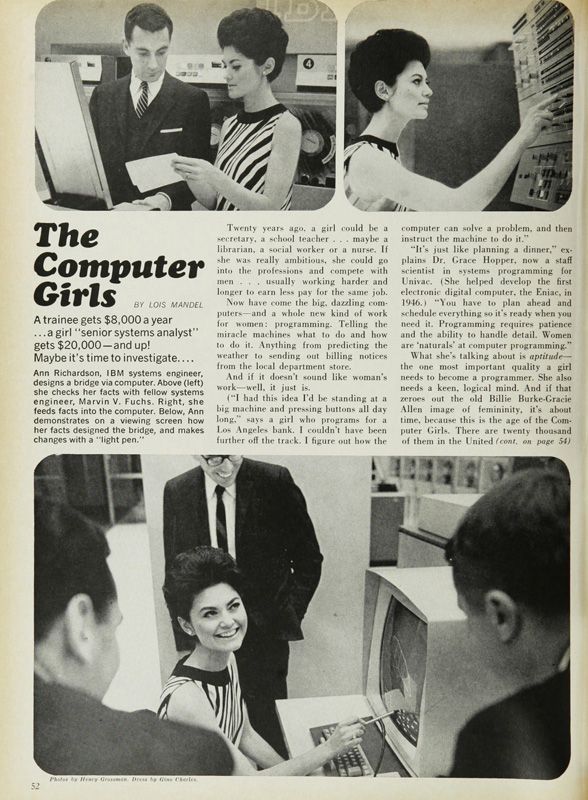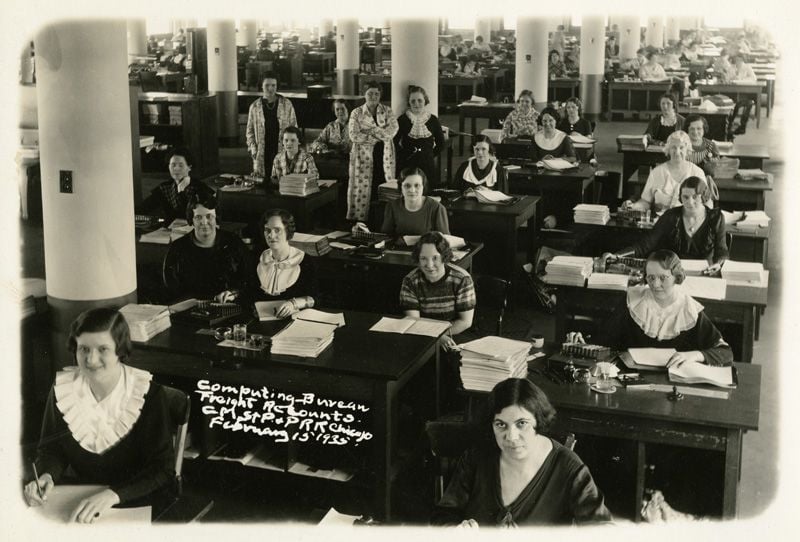NATIONAL MUSEUM OF AMERICAN HISTORY
When Computer Programming Was ‘Just Like Planning a Dinner
Women were encouraged to seek employment in computing by appealing to traditional domestic roles
/https://tf-cmsv2-smithsonianmag-media.s3.amazonaws.com/filer_public/37/7f/377f1700-d90f-4be0-91f9-4ca172eddc60/cosmo_ad_copy.jpg)
In 1967, the magazine Cosmopolitan featured an article about the growing number of job opportunities for women in computer programming. In the article, computing pioneer Dr. Grace Murray Hopper attempted to appeal to the magazine’s readership, commenting on the profession: “It’s just like planning a dinner. . .You have to plan ahead and schedule everything so it’s ready when you need it. Programming requires patience and the ability to handle detail. Women are ‘naturals’ at computer programming.”

We can’t know whether Dr. Hopper really believed that women were naturally suited for computer programming. Her comment most likely served the rhetorical strategy of encouraging women to seek employment in the field by appealing to the (feminized) domestic role of homemaker. Moreover, Hopper’s quote and the article as a whole did two seemingly opposing things: they simultaneously reinforced traditional gender roles and expanded people’s assumptions about what work women could do. By drawing on the supposed innate talent of women to perform certain tasks, namely, planning a dinner and programming a computer, the magazine upheld normative assumptions about "women’s work” while also pushing the bounds of that idea to include computer programming.
Left unsaid in the 1967 article was the fact that women had already made a lasting impact on computer programming; they were programmers even before the work was called “programming.” These (mainly white) women who helped shape the growing field performed calculations and plugged patch cords into the earliest electronic digital machines of the 1940s. However, at the time, few gained recognition for their work, which was distinct from systems design and engineering, jobs overwhelmingly held by white men.
Were women really naturally suited for programming? Gendered work is work assumed to be suited for someone based on norms and expectations for feminine or masculine behavior. It presumes that men and women have distinct skill sets and that they’re naturally inclined to be better suited for certain jobs. Assumptions about which gender is best suited to work which job—including the unpaid feminized labor of childrearing and housework—have influenced workforce demographics and pay rates. Indeed, like in many other industries, expectations around what kind of work was best suited for men and women helped shape the modern field of computing and the business of data processing. In the 1950s, the field of computer programming began to professionalize, at which point women were welcomed into the workforce but shut out of upper management jobs. By the 1960s, some aspects of computer programming and information processing jobs, especially those in office environments, were considered clerical in nature, even though they required technical skill and a sophisticated aptitude for mathematics. White women were actively fed into this employment pipeline for programming and data processing tasks that aligned with feminized office work. This trend mirrored the earlier emergence of pre-electronic computational (number-crunching) work as well as stenography, two white-collar jobs deemed suitable for working women in the late 1800s and early 1900s.

Documenting histories of women in computing is just the first step in creating more richly layered and equitable historical narratives about technology, information, and society. But we need to go further by thinking critically about the norms that underlie the way people relate to each other, including what bearing these norms had—and continue to have—in our daily lives. The claim that women had a “natural” talent for programming obscured the material circumstances behind that rationale. Beginning in the 1950s, automation and computerization meant that more and more businesses were purchasing large digital computer systems for information processing, prompting a growing demand for educated workers with an aptitude for programming. Companies were keen on recruiting women—a demographic typically considered cheaper and more obedient than men—as programmers, systems analysts, data processors, and key-punch operators. This latter position was strictly clerical and attracted women workers in large numbers. Key-punch operators prepared raw data on punch cards, and information coded on those punch cards was then fed into electronic computers for data processing at insurance companies, banks, government agencies, and many other businesses and institutions.
Whether it was done consciously or subconsciously, citing women’s “natural” talent for this sort of work was one way that (mostly male) managers contributed to keeping women in subservient jobs. As historian Mar Hicks has shown in their book, Programmed Inequality, assumptions about women’s heterosexuality and their plans to marry and have children factored into the management of women personnel, leading some managers to overlook their female staff as candidates for promotion. Managers more readily promoted white, college educated men instead of their (again, mostly white) female colleagues, even though some women had more relevant work experience than their male competitors. It is worth mentioning that while most workers reported to male managers, some women became heads of their units or broke away from their employers to start their own businesses. A few have been recognized as “pioneers” in computing, and the National Museum of American History is fortunate to have objects and archival papers of two highly accomplished computing professionals who happened to be women, Grace Murray Hopper and Margaret R. Fox.
Even though we can’t know whether Dr. Hopper really believed that computer programming was “just like planning a dinner,” we should consider the role of social norms in the lives of historical actors. It is not until we examine how gender norms have operated in society and how they have changed over time that we will better understand both the diversity of women’s experiences, and the significance of informatics and computers in society.
This post was originally published on the National Museum of American History's blog on September 30, 2021. Read the original version here.
